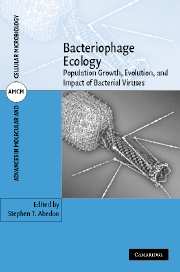Book contents
- Frontmatter
- Contents
- About the cover
- List of contributors
- Foreword by Bruce R. Levin
- Preface
- 1 Phages, ecology, evolution
- Part I Phage ecology
- Part II Phage evolutionary biology
- Part III Phage ecology in environments
- Part IV Modeling phage ecology
- 15 Modeling bacteriophage population growth
- 16 Modeling phage plaque growth
- 17 Modeling of bacteriophage therapy
- Index
- Plate section
17 - Modeling of bacteriophage therapy
from Part IV - Modeling phage ecology
Published online by Cambridge University Press: 29 September 2009
- Frontmatter
- Contents
- About the cover
- List of contributors
- Foreword by Bruce R. Levin
- Preface
- 1 Phages, ecology, evolution
- Part I Phage ecology
- Part II Phage evolutionary biology
- Part III Phage ecology in environments
- Part IV Modeling phage ecology
- 15 Modeling bacteriophage population growth
- 16 Modeling phage plaque growth
- 17 Modeling of bacteriophage therapy
- Index
- Plate section
Summary
INTRODUCTION
Bacteriophage therapy, the treatment of bacterial infections with bacteriophages, is a topic that has received increasing attention in recent years. While the primary practice of phage therapy has been conducted with an eye towards the treatment of bacterial infections in humans, the concept of eliminating undesirable bacterial populations using phages can be extended to agriculturally important animals, plants, and even finished foodstuffs. While the potential benefits of phage therapy have been well documented, the mechanisms of phage therapy are less well understood, except in general terms. There is little in the way of standard criteria for selecting dose size, timing, or frequency when treating bacterial infections with phages. One approach toward addressing such concerns attempts to gain a better understanding of the in vivo reality of phage therapy through the development of theoretical mathematical models. Most models have comprised a series of differential equations, with theoretical parameters selected to examine the impacts of various phage therapy constraints. In this chapter I give a basic overview of the mathematical modeling approaches which have been applied to simulate phage therapy regimens. Simulations will be provided, where appropriate, to illustrate the behavior of these models. Finally, I briefly explore the current limitations of modeling given our understanding of how phages and bacteria interact in vivo.
- Type
- Chapter
- Information
- Bacteriophage EcologyPopulation Growth, Evolution, and Impact of Bacterial Viruses, pp. 439 - 464Publisher: Cambridge University PressPrint publication year: 2008
- 7
- Cited by



